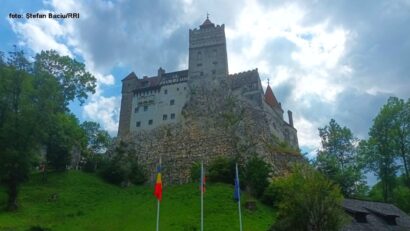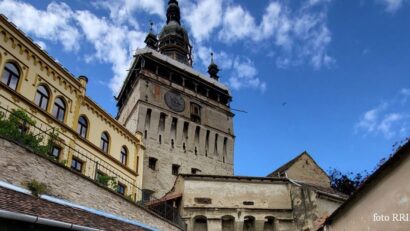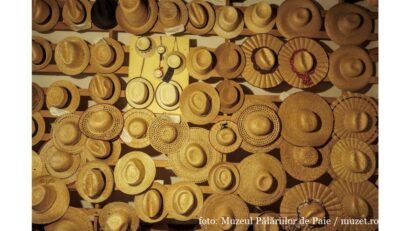Monuments in Oradea
Oradea is a surprising city when it comes to heritage monuments

Daniel Onea, 12.05.2022, 17:16
Oradea is a surprising city when it comes to heritage monuments. European Best Destinations, a well-known platform promoting tourism, included Oradea on the list of perfect destinations for a city break, referring to the city as a concentration of Art Nouveau in the heart of Europe. By simply strolling through the city, you can discover important buildings, going back to the 16th century.
For centuries, the city of Oradea has been a major point of reference, as a major cultural and trade hub. In the Middle Ages, the citadel of the city had an astronomical observatory. The astronomers working there used the citadel of Oradea as the reference meridian. The city was first documented in 1113, and the citadel appears in documents for the first time in 1241. Ionut Ciorba, deputy director of the Oradea City Museum, told us about the rich and diverse history of the city, almost a millennium long:
“Along the years, our citadel was a defensive place, but equally it was an episcopal seat, a religious center, right from its very beginnings. The Roman Catholic Bishopric of Oradea was within the city walls. Then, the citadel was a place of rest for crowned heads, supposedly for eternity, but unfortunately that didnt come to be. Several kings and queens were laid to rest in the citadel, but unfortunately for us, their tombs are no longer here. Among them is King Ladislau I, whose name is tied to the founding of the city. After his death, he was canonized. Then there were Andrew II, king of Hungary, Ladislau IV The Cuman, Sigismund of Luxemboug, king of Hungary and Emperor of the Holy Roman Empire, his wife, Queen Maria, Queen Beatrix, wife to Carl Robert of Anjou, as well as a daughter to Wallachian king Nicolae Alexandru, who was also laid to rest here.”
In the central part of the city you can see old buildings, some built in the 16th century. In Oradea they have a series of Baroque monuments, and the most representative would be the Baroque Palace. At the same time, the historic center area stands out with its rich Art Nouveau architecture, buildings of rare beauty, among them the State Theater, City Hall, and the Apollo, Stern, Poinar, and Moskovitz palaces. In fact, in 2012 Oradea was included in the European Art Nouveau network, alongside cities with such heritage buildings as Vienna, Budapest, and Barcelona. Starting last year, they have a museum dedicated to the Art Nouveau style. It is the first of its kind in Romania. The Darvas-La Roche house is already a symbol of the city of Oradea. It is an Art Nouveau heritage building, and a masterpiece of the geometric Secession style by the brothers Jozsef and Laszlo Vago, according to Angela Lupsa, executive director of the Foundation for the Bihor- Oradea Historic Monument Protection:
“The two were famous at the turn of the century for what they planned and built. After an ample process of restoration, between 2018 and 2020, the Darvas- La Roche House opened its gates in the year of the pandemic in splendid condition. We are talking about a wholesale restoration of the decorations in the house, the ceramics on the facade, the wrought iron decorations, everything specific to the Art Nouveau style. Inside we find halls that have been returned to their previous function, and we can say about them that they have a special type of decoration, as a veritable incursion back in time.”
Visitors may stroll through the living room and discover a period cupboard, for instance, richly ornate, restored to the tiniest detail, says Angela Lupsa:
“This is down to the smallest detail of the cupboard, such as the drawers, where you may find silverware specific to a certain dish, or a period tea kettle. Of course, the stroll through these spaces continues at the top floor with a visiting salon, where we can discover the noblemens passion for tobacco, and see some of the paraphernalia. In the salon for the ladies we can see perfume bottles and other accessories used at turn of century for display in high society. We are talking about a space that transports you in time, and connects with everything that happened in society cca. 1910. Just as Oradea was full of palaces in Art Nouveau style, society matched this style, displaying in public all kinds of activities that were novel for that time.”
In this museum you can find a section dedicated to the Jewish owners, who were deported and exterminated at Auschwitz. Here is foundation director Angela Lupsa:
“This is a bedroom which is not in the Art Nouveau style, but which, since it belonged to the owners of that time, was preserved as it was in the memory of those that never returned. We are talking about proprietors and investors of the time, with extraordinary financial potential, such as Imre Darvas, a Jewish neurologist, who wanted this house to be on two street fronts, and to have a view from the house terrace of a synagogue whose member he was. And so a visit to this house tempts one to go on a further visit to a monument that is part of the Oradea Heritage, as we are known online.”
We wrap up this edition with good news for the tourists. For the third year in a row, we are welcoming tourists with a bunch of benefits and discounts, as part of a campaign called Oradea with Fondness, running up until December 31, 2022. As part of this campaign, tourists who take accommodation in one of the units in the city for at least two nights in a row may enjoy many benefits this year too. They include free access to all the museums that are part of the Oradea Cris Country Museum network, and to tourist objectives that are part of Oradea Heritage. They also get free of charge transportation, 24 hours a day, in the public transportation network, and attractive discounts at partner cafes and restaurants in Oradea. Tourist registration, generation of codes for discounts and special offers, and communication with the partners in the campaign are done through the website oradealifenouveau.ro.






























